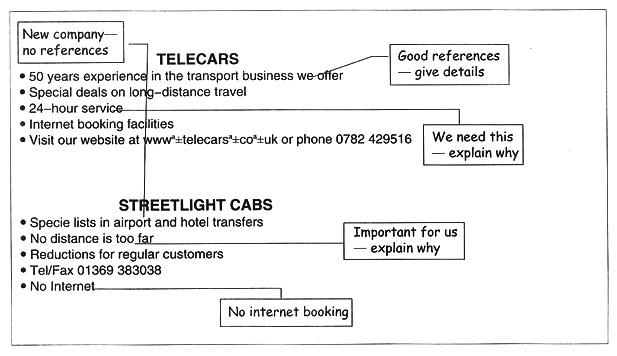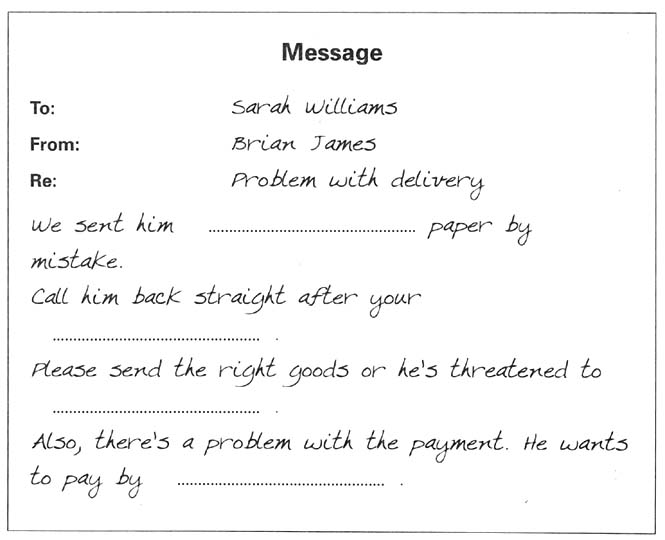1.
PART ONE In this part, the interlocutor asks questions to each of the candidates in turn. You have to give information about yourself and express personal opinions.
PART TWO In this part of the test, you are asked to give a short talk on a business topic. You have to choose one of the topics from the three below and then talk for about one minute. You have one minute to prepare your ideas.
A: What is important when...?
Planning a presentation
●Audience
●Equipment needed
●
●
B: What is important when...?
Selecting an interpreter for a meeting with foreign clients
●Experience
●Reliability
●
●
C: What is important when...?
Introducing a new product range onto the market
●Timing
●Advance publicity
●
●
PART THREE In this part of the test, you are given a discussion topic. You have 30 seconds to look at the task prompt, an example of which is below, and then about three minutes to discuss the topic with your partner. After that, the examiner will ask you more questions related to the topic.
For two candidates
Selling old stock
The manufacturing company you work for needs to make space in its warehouse to stock its new products. The company would like to sell off end-of-range products at discounted prices.
You have been asked to make recommendations.
Discuss the situation together and decide:
●whether to offer the same discount on all products
●how customers could be informed of the discounts.
For three candidates
Selling old stock
The manufacturing company you work for needs to make space in its warehouse to stock its new products. The company would like to sell off end-of-range products at discounted prices.
You have been asked to make recommendations.
Discuss the situation together and decide:
●how much discount should be offered
●whether to offer the same discount on all products
●how customers could be informed of the discounts.
Follow-on questions ●Do you think discounts are a good way of selling old stock? (Why?/Why not?)
●In what other ways do you think companies can get rid of unwanted stock? (Why?)
●What do you think is the main disadvantage for a company of having too much stock in its warehouse?
●How do you think companies could plan their stock requirements more accurately?
●Why do you think it can be difficult to sell stock sometimes?
●How do you think discounting could affect a company's image? (Why?)
INTERLOCUTOR FRAMES
To facilitate practice for the Speaking test, the scripts followed by the interlocutor for Parts 2 and 3 appear below. They should be used in conjunction with Tests 1-4 Speaking tasks. These tasks are contained in booklets in the real Speaking test.
Interlocutor frames are not included for Part 1, in which the interlocutor asks the candidates questions directly rather than asking them to perform tasks.
Part 2: Mini presentations (about six minutes)
Interlocutor:
●Now, in this part of the test I'm going to give each of you a choice of three different topics. I'd like you to select one of the topics and give a short presentation on it for about a minute. You will have a minute to prepare this and you can make notes if you wish. After you have finished your talk, your partner will ask you a question.
●All right? Here are your topics. Please don't write anything in the booklet.
[Interlocutor bands each candidate a booklet and a pencil and paper for notes.]
Interlocutor:
●Now, B, which topic have you chosen, A, B or C?
●Would you like to talk about what you think is important when [interlocutor states candidate's chosen topic]? A, please listen carefully to B's talk and then ask him/her a question about it.
[Candidate B speaks for one minute.]
Interlocutor:
●Thank you. Now, A, please ask B a question about his/her talk.
[Candidate A asks a question.]
Interlocutor:
●Now, A, which topic have you chosen, A, B or C?
●Would you like to talk about what you think is important when [interlocutor states candidate's chosen topic]? B, please listen carefully to A's talk and then ask him/her a question about it.
[Candidate A speaks for one minute.]
Interlocutor:
●Thank you. Now, B, please ask A a question about his/her talk.
[Candidate B asks a question.]
Interlocutor:
●Thank you.
●Can I have the booklets, please?
Part 3: Collaborative task and discussion about seven minutes)
Interlocutor:
●Now, in this part of the test, you are going to discuss something together.
[Interlocutor holds the Part 3 booklet open at the task while giving the instructions below.]
Interlocutor:
●You have 30 seconds to read this task carefully, and then about three minutes to discuss and decide about it together. You should give reasons for your decisions and opinions. You don't need to write anything. Is that clear?
[Interlocutor places the booklet in front of the candidates so they can both see it.]
Interlocutor:
●I'm just going to listen and then ask you to stop after about three minutes. Please speak so that we can hear you.
[Candidates have about three minutes to complete the task.]
Interlocutor:
●Can I have the booklet, please?
[Interlocutor asks one or more of the following questions as appropriate, to extend the discussion.]
Examples:
●Do you think magazines are a good way to keep staff informed? (Why?/Why not?)
●Do you think companies of all sizes should have staff magazines? (Why?/Why not?)
●Is it important for senior managers to contribute to staff magazines? (Why?/Why not?)
●Would you like to contribute to staff magazines? (Why?/Why not?)
●Do you think an internal company website would be a good way of keeping staff informed? (Why?/Why not?)
●Do you think magazines for customers are a useful marketing tool? (Why?/Why not?)
●Thank you. That is the end of the test.



